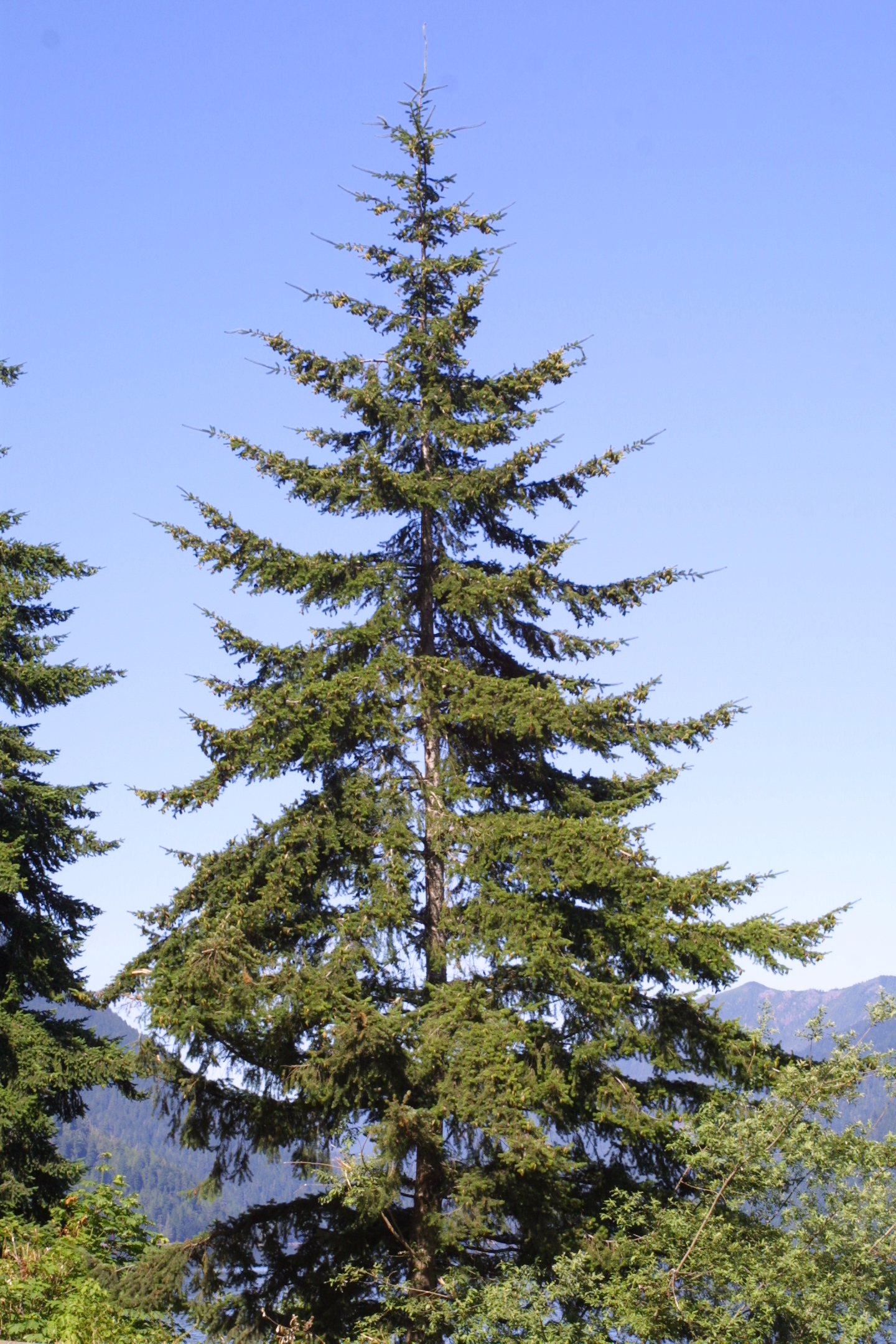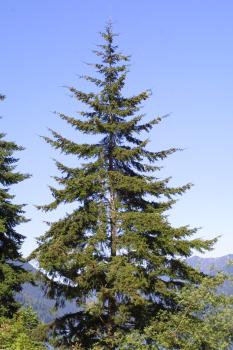Douglas Fir (Pseudotsuga menziesii)

Common Name(s): Douglas-fir, Coast Douglas Fir
Scientific Name(s): Pseudotsuga menziesii
Island Hulkemel'em Name(s): sleyuhp (Downriver name), c'sey' (Island name)
Family: Pinaceae
Cautions: None
Botanical Description: A large evergreen coniferous tree with two types: coastal and interior. On the coast, they reach heights of 85 m and in the interior they reach 42 m. In older douglas-fir trees the crown is flattened and rounded, while the trunk is long with no branches. Young trees have a pointed crown and have smooth, greyish-brown bark with resin filled pockets. With age, the bark becomes dark brown and becomes very thick and ridged, as some trees are around 1000 years old. Needles are flat with a pointed tip and spread around the twig. The top is bright yellowish-green, or darker green, while the lower surface is lighter and has two longitudinal bands of white stomata. The cones are 5-11 cm long and are green when young, turning grey as they mature. There are three protruding bracts between each scale.[1]

Current Distribution and Local Habitat(s): The coastal variety of douglas-fir occurs along the southern mainland coast and across Vancouver Island, except for the northern part of the island. The interior variety occurs throughout southern BC and North to Takla Lake. They grow in moist soils and prefer full sun. Coastal douglas-fir ecosystems are more productive than the interior ecosystems. Douglas-fir trees often grow with western red cedar, hemlock, and grand fir, with salal, huckleberries, Oregon-grape, and sword fern in the understory. The interior ecosystem often includes open forests with pinegrass and mosses beneath. Many animals such as squirrels, chipmunks, mice, shrews, winter wrens, and crossbills eat the cones and help spread the seed across their environment. Bears also use their tough claws to scrape the bark and eat the sap layer underneath.[2]
Ethnobotanical Application(s): Indigenous groups throughout BC have had a wide variety of uses for douglas-fir trees. The wood and the boughs were used as fuel for pit cooks, the boughs were also used in bedding and to cover the floor of lodges and sweat lodges. The wood is extremely valued because it is hard and durable making it perfect for construction. This has led to major logging throughout BC. There are also many medicinal uses for the sap, pines, and bark of douglas fir trees. Dried sap was chewed to help fight cold symptoms, and a poultice, created from the pitch, was applied to injuries. Liquid pitch combined with inner bark was used on cuts, boils, sores and various other skin problems. Young needles are high in vitamin C, and therefore needle tea was often used to treat scurvy. Douglas-fir bark was ground up and used as a laxative tea to help with digestive problems. Douglas-fir trees were also used to create a crystalline sugar, often called "douglas-fir sugar" or "wild sugar." It was gathered from branches on specific trees in the interior of BC and was used as a confection and sweetener. It was traded to upper BC and among other nearby groups, and was extremely rare and valued, yet it has rarely been seen as of recent.[3]
Herbal Tea Recipe: You will need one and a half tablespoons of douglas-fir pines and/or bark per cup of water. Pick pines off the branches, ensuring you are not taking too much from one area. As these trees are generally big; working your way around the tree will ensure no one specific area is stressed severely. If using bark, start on the South side and remove bark around the tree, taking only what you need. The pines then must be dried for a couple days, whereas bark needs to be dried for a minimum of a week, and then cut or ground up. Either directly place one and a half tablespoons into a boiling cup of water, or fill an empty tea bag with the pines/bark and steep it for 15-20 minutes. If pines/bark directly placed into the water, strain the tea first and enjoy!
UVic Campus Location(s): Mystic Vale, Bowker Creek, South Woods, Finnerty Gardens, Cunningham Woods
Figure Reference(s):
Figure 1: https://www.sfu.ca/geog/geog351fall07/Group06/Coastal%20Douglas-Fir.html
Figure 2: http://linnet.geog.ubc.ca/Atlas/Atlas.aspx?sciname=Pseudotsuga%20menzies....
[1] BC Forest Ministry (n.d.). Douglas-fir. Retrieved June 29, 2016, from https://www.for.gov.bc.ca/hfd/library/documents/treebook/douglasfir.htm.
[2] Klinkenberg, B. (2015). E-Flora BC: Electronic Atlas of the Plants of British Columbia. Lab for Advanced Spatial Analysis, Department of Geography, University of British Columbia, Vancouver. Retrieved June 29, 2016, from http://linnet.geog.ubc.ca/Atlas/Atlas.aspx?sciname=Pseudotsuga%20menzies....
[3] Kuhnlein, H. V., 1939, & Turner, N. J., 1947. (1991). Traditional plant foods of canadian indigenous peoples: Nutrition, botany and use. Philadelphia: Gordon and Breach.
Project Status:
Date Completed:
Year:
Associated Projects:
Image:

